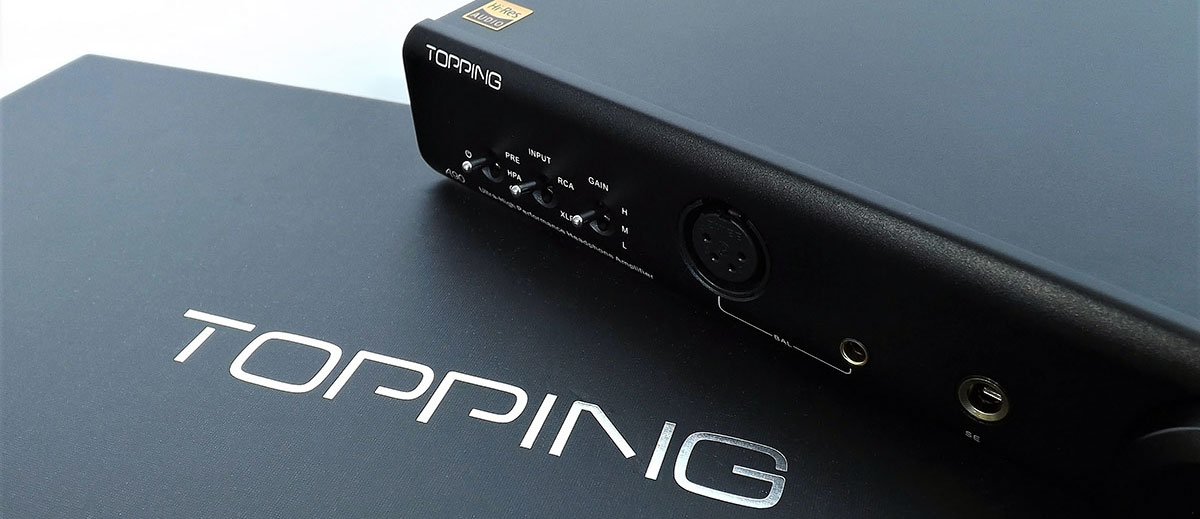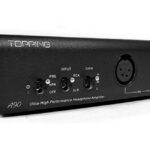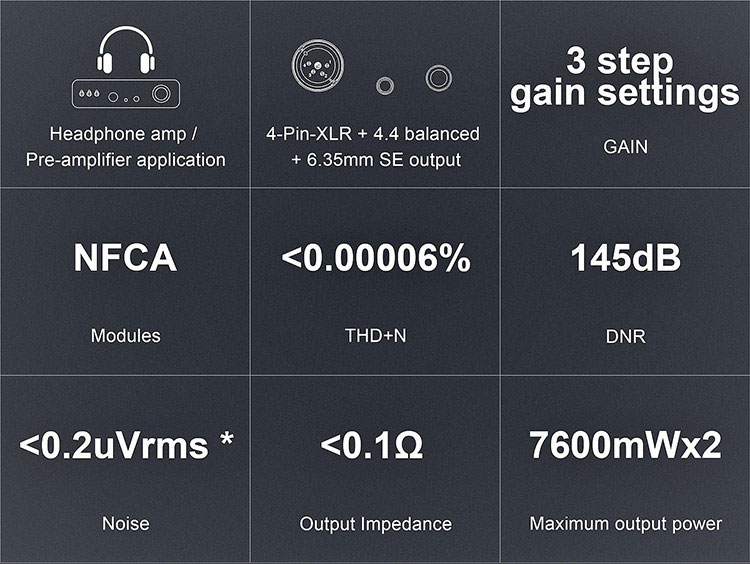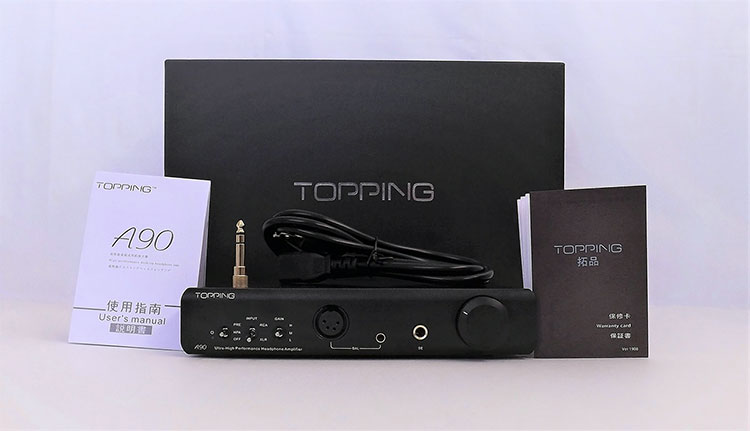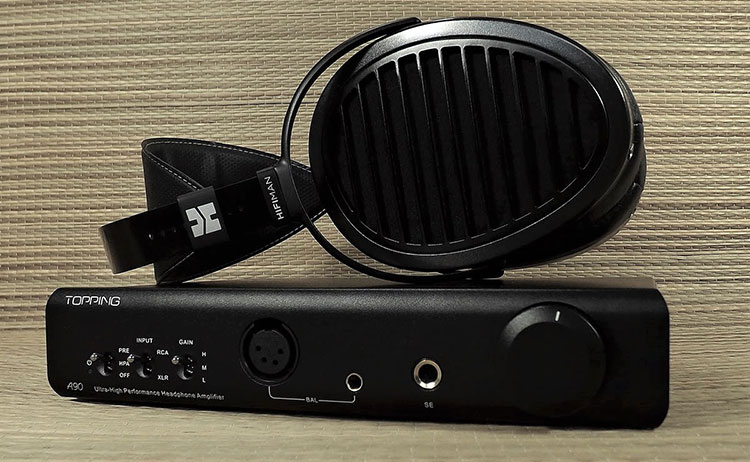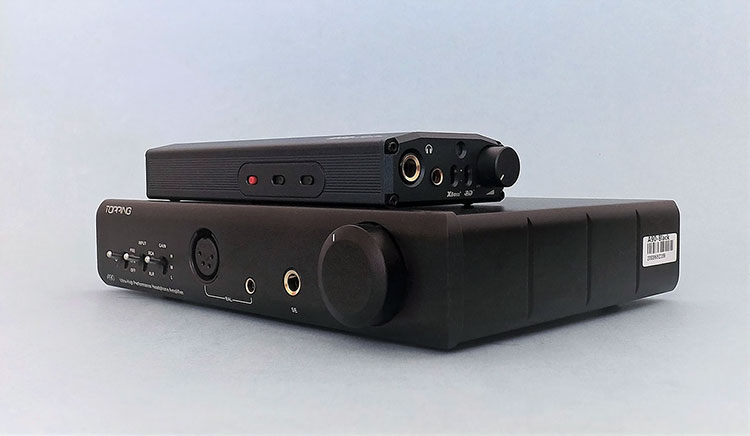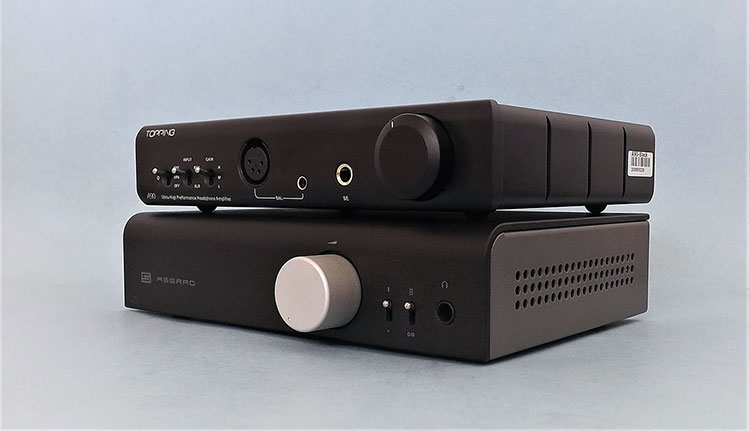The Topping A90 is a compact balanced desktop headphone amplifier featuring both XLR and 4.4mm outputs and offering up to 7.6W of power. It is priced at $499.99
Disclaimer: The Topping A90 sent to us is a sample in exchange for our honest opinion. We thank the team at Linsoul for giving us this opportunity.
To read more about Topping products we have reviewed on Headfonics click here.
Note, this review follows our new scoring guidelines for 2021 which you can read up on here.
There are many manufacturers making headphone amplifiers nowadays and I can name probably at least two dozen companies that make excellent models. What does it take to break in heavily into that market today with another model?
The answer is either something different or better than the rest. So did Topping do that with their A90 headphone amplifier? It does have new technology so let’s check it out because it recently arrived at Headfonics for review.
Another claim we have to analyze with this particular model is the claim that Topping makes of labeling the A90 as an ultra-high-performance headphone amplifier. Is it? Let’s see.
Tech Highlights
NFCA Modules
The Topping A90 is unique in the sense that it employs a newly designed circuitry and a new technology called Nested Feedback Composite Amplifier module centric design or NFCA which on paper and lab measurements claim very good numbers.
These new ultra-high performance high current hybrid feedback architecture modules which also have UHGF, which is ultra high gain feedback, allowed Topping to build this hybrid design amplifier with excellent DC and AC performance, high output current drive capability, and extremely low distortion.
Other benefits of these modules and circuitry design is an ultra low noise down to 0.2uVrms and a very high dynamic range of 145 decibels making this amplifier one of the most noise-free designs out there.
This amplifier design is an excellent platform in general due to the fact that it can dish out a maximum of 7.6 watts on the balanced side per channel enabling it to push any headphone sold today with ease while also remaining capable of a low voltage output that is completely free from hiss with practically every hiss sensitive IEM out there.
Three Stage Gain
The Topping A90 has on the front panel a 3 position gain switch. The three settings are labeled as low, medium, and high which is a common setup.
What makes this gain interesting? On the lowest gain setting, the Topping A90 specs out at a mere 0.00006% distortion which is a rather impressive number. It seems Topping is rather proud of their measurements and print them on their website so all those graphs interpreting critics can compare numbers.
With that spec, a low 0.2uVrms noise specification, but also the fact that along with the high output current and a less than 0.1Ω output impedance and all these specs in combination could only mean one thing, it means great results and noise-free sound regardless of what headphone you use. Topping promises a very dark background with the A90 design.
Preamplifier Feature
The Topping is not just a headphone amplifier but it can also act as a preamplifier. It takes any compatible input and through the use of the volume control plus the front panel input selector plays the preamplifier part very well.
The Topping A90 can output a signal on both available outputs simultaneously making this amplifier versatile enough to become the centerpiece of your desktop audio setup by having the ability to drive headphones, or external amplifiers with RCA inputs or XLR connectors all at the same time with selectable inputs.
Design
The Topping A90 body is made entirely of metal and comes in black or silver. The front panel switches and the volume control button are also made of metal. The volume knob has the same finish as the body.
The black version which is the one we got has a textured finish. I have seen the silver version and the texture seems the same. The unit feels heavy when you pick it up and feels well constructed.
One thing I have noticed is that there are two versions of the A90 floating around at the time of this writing. Some reviewers complained that the volume control knob is too narrow so this second version has a volume knob that protrudes I would say an extra 10mm or 12mm. It seems that Topping is listening to its target audience.
Rear Panel Connections
On the back panel of the Topping A90 and to the left side is the input section with a pair of XLR and a set of RCA stereo inputs. All connections, inputs or outputs, are obviously analog on this amplifier preamplifier combo.
More to the center of the rear panel are a set of identical connectors, only their functions turn into outputs and as mentioned previously, both can be used simultaneously either in fixed mode or variable depending on the front panel preamplifier switch position.
On the right side is the full-sized 3 prong AC connector. There is also an on/off switch. Here is where a question came to mind. Why are there 2 power switches? That is because while the front power button is in the preamp mode, this amplifier is capable of going into standby mode and activating when a signal is introduced.
This enables the user to just leave the unit on all the time. One note which needs to be mentioned and should always be of concern leaving electronics on all the time is the operating temperature but this unit rarely gets warm to the touch so it would be safe to do so with this model in my opinion.
Front Panel Connections
The topping A90 has three headphone connections accessible on the front panel. I only recommend using one at a time and most amplifiers with multiple connections are similar. This amplifier has a good set of plugs which should cover most headphone cables.
The common old school 6.35mm TRS stereo plug is included which can easily be turned into a 3.5mm TRS plug with the included adapter. There’s also some new tech connectivity available.
There’s also a 4.4mm TRRRS Pentaconn plug alongside an XLR 4 pin connector and both these connectors are balanced outputs that should be used to obtain the maximum power output available for hard-to-drive cans. So in total, you get four connections possible out of the box.
Front-mounted Power Switch
When I first took the Topping A90 out of the box, I saw the rear power button first and let off a long sigh. Then I saw the front panel power switch and was relieved and was able to breathe again.
I simply dislike the fact that some amplifier models nowadays have a single rear power button which to me is impractical and uncomfortable to reach especially if installed in a tight spot.
This power button has a dual function and can turn this unit on and also go into preamplifier mode.
Packaging & Accessories
Do not expect to get some XLR, RCA wires, or any wires for connectivity when you buy the Topping A90 because none are included in the box or much else. The only wire you get is the heavy-duty full-side power chord plus a 6.35mm to 3.5mm adapter. Inside the box, you also get a user’s manual and a warranty card which doubles up as a product brochure.
It all comes in a black box that measures 14.5 inches by 9.5 by 3.5 inches and all the contents are placed inside molded dark charcoal grey foam which ensures the amplifier will get home safely. The amplifier itself measures 4.5cm x 22.2cm x 16cm.
A90 Sound Impressions
The beauty of the Topping A90 headphone amplifier sound signature is that there is no sound signature. Other amplifiers have qualities that could either be described as warm, sterile, sharp, or tube-like. What you get here is what you put in basically.
The Topping has a very neutral and balanced sound with a very dark and silent background. The A90 has a very smooth top end with clean and very accurate bass. The midrange comes through perfectly and smoothly, and you could hear what a recording really sounds like with this amplifier. Not only the recording but you could also tell the differences in DACs.
I used the A90 with a variety of DACs from the smallest micro DAC to a Bluetooth DAC like the FIIO BTA30, and I also used an iFi NEO using the XLR connectivity and you could really tell what each DAC sounds like which is a very good character of this amplifier in particular. As mentioned before it makes an excellent test platform and yet still remains musical and involving.
Noise levels
The Topping A90 has the ability to function completely silent. A reader recently asked me to test a couple of IEMs which are very sensitive to noise and hiss and found the ones who hiss the most. If I used the A90 in the low gain setting, the amp section was completely silent and there was barely any even on the medium setting with these particular IEMs.
I tested many IEMs with Balanced Armature super tweeters, electrostatic and dynamic driver IEMs which also tend to hiss a lot and obtained the same hiss free character. I would not recommend this amplifier to be used on the high gain setting on IEMs anyway because it’s just too powerful and I would reserve that setting for power-hungry headphones.
Synergy
I must have pulled all the stops when it came to feeding the Topping A90 by using every source I had and not once was I disappointed except for a few times when I realized how terrible the internal DAC was from the source.
To describe just some of my experiences, I have 3 amplifiers that use the same AK4490DAC chip. These three are the FIIO BTA30 which can act as a DAC, an iFi Micro iDSD Signature series and a Focal Arche.
I could really tell the difference in quality from the three. The FIIO was at the bottom because the DAC on this unit is just a side feature. It sounded adequate enough to be fairly enjoyable but there was a loss in smoothness. But one could not tell until you heard a superior DAC through the A90.
The iFi was in second place but had some noise in the form of hiss but more absent using the USB DAC portion against the Optical for some reason. The Arche was the cleanest and best demonstrated the AK4490 DAC warm qualities that lots of audiophiles like from the particular chip.
Selective Comparisons
iFi Micro iDSD Signature
Technical
Do good things come in small packages? Yes, they do and the Micro iDSD signature is a perfect example of that. Since they both put out the goods in the form of power and since the iFi unit is capable of acting as a standalone analog amplifier, I would consider it a fair fight regardless.
If size matters, think audio and desktop space, then the iFi Micro iDSD signature will be more appealing because it has more features than most amp DAC combo setups and does so while taking up a very small amount of space doing everything you need it to do and then some because you could also go portable with this device.
If you want features I urge you to check this model out. The list of features includes a 3 selectable DAC mode switch, iEMatch, 3 power output settings, XBass, and 3D.
You also get digital and analog inputs, single-ended and balanced headphone output and S balanced with a maximum power output of 4.1 watts that can go portable and you have one fun and formidable machine that will take care of most music lover’s needs.
Sound
I compared amplification sections by feeding the iFi unit through the line-in plug with the same sources I fed the Topping A90 to make it a fair comparison. I used the RCA ins and outs since the iFi unit does not have a balanced input section.
The noise floor was higher on the iFi unit but the one quality I most enjoyed from the Signature series is the warm-sounding characteristics that could improve some headphones and IEMs by engaging some of its features like XBass or the 3D function.
The Topping A90 had the darker background regardless of gain settings or iEMatch in the case of the iFi unit but both models remained musical in their own way.
The iFi Signature seemed more dynamic and warmer while the Topping A90 remained smoother especially in the mid and upper regions with a more effortless top volume level due to the extra power comparing both units using the 4.4mm output connection.
Schiit Asgard 3
Technical
Schiit audio makes some robust models far as construction plus they are made in the USA from most parts sourced locally. For the price, it’s practically unbeatable but the unit is utilitarian and feature-free, to say the least, and comes in a plain brown box.
Unboxing experiences are rarely discussed over at Schiit audio and honestly, they are just my kind of people because they give you product value over trinkets and boxes wrapped in leather.
The Asgard has a single 6.35mm headphone output and one set of stereo RCA inputs. It has a second set of RCA plugs but these are for the preamplifier section which the Asgard is capable of also acting as but with just a single input source.
Both these units are AC power fed by a full-size 3 prong grounded wire and do not use wall warts. The Schiit Asgard is the more robustly built and heavier unit but lacks in features and is designed for people who want a good-sounding simple amplifier.
Sound
The Schiit Asgard is a hybrid class A/AB design that tends to sound warm with a soft relaxed toned midsection and highs that are not bothersome or intense and well-controlled until you raise the volume up to loud levels and it kicks into class AB which is not clean as the first stage.
At low to medium volumes, the Asgard is a pleasure to listen to but at higher volume levels the Topping tops it. Get it?
Of course, the question arises that is it fair to compare a 200 dollar unit to one that costs 500? Not really and unfortunately I do now own any of the THX models which are comparable in cost but the word around the net is that this one gives them a run especially in raw output power, hiss free operation with a smoother tonality free from sharp edgy sound characteristics. Let’s leave it there.
Honestly, the Asgard for the price is one of the best at that price point and will satisfy most music lovers because it does sound better and more musical versus for instance its baby brother the Magni, or other budget headphone amplifier models.
IFi iDSD NEO
Technical
The Neo as I playfully call it is a DAC headphone amplifier which again lacks features but its main niche is the cleanliness and purity of the sound and silent operation with no weird artifacts, hiss static, interference, or even turn on or turn off thumps, completely silent.
I have grown to really like the NEO and appreciate its qualities of producing clean unaltered sound especially out of the rear XLR output ports or the headphone output plugs up front although they have a lack of drive power.
For highly efficient headphones and IEMs, it works and I even got great results from headphones like the Focal Utopia or the Stellias but not with my Hifiman Arya. They just required more power.
Sound
I really wanted to throw this unit into the mix, although technically it’s not a headphone amplifier and cannot function as one and could only output from its rear input jacks or rear outputs once it receives a digital source or a Bluetooth transmission.
Why then? Because this makes an excellent combo that sounds terrific and could drive any headphone made while maintaining a totally dark background, free from static, clicks, pops, and noise in general.
As previously mentioned the Topping A90 saw about 8 different sources while I was testing it out but only when I paired these two together is when I got the full picture.
Great precise imaging, great bass, and a high-frequency section that is sharp and crisp with a midrange that is smooth as glass. My Aryas absolutely love this combo and my other headphones too and I bet this combo can compete with some combo pieces costing twice as much.
Our Verdict
The Topping A90 is a bargain when it comes to high-quality headphone amplification. Just three years ago similar performance would have cost closer to 3 grand and I’m sure this model will satisfy most music lovers and even some ardent audiophiles. The fact that it can also act as a preamplifier is a bonus.
The Topping A90 has a very keen ability to take a signal and amplifying it without altering its tonality and is completely neutral doing what it’s supposed to do, amplify and it does it effortlessly with lots of power at its disposal. This is a high value for the buck amplifier and deserves the ultra-high performance label.
I am going to point at myself because lately, most of the products I reviewed this year are getting high scores but it’s not my fault so much good stuff is being released. The Topping A90 is no exception except it actually is because I doubt you could do better for the price on the current market. High scores it gets indeed and it looks like it’s going to be a very good year.
Topping A90 Specifications
- Type Analog / Balanced Headphone amplifier / Preamplifier
- Connectivity 4 pin XLR / 4.4 Balanced / 6.35mm SE output
- Gain Low / Medium / High
- Technology NFCA Module Amplification with Ultra High Gain Feedback
- THD 0.0006%
- DNR 145 Decibels
- Noise 0.2uVrms
- Output Impedance 0.1 ohms
- Max power output 7600W x 2

